check engine AUDI Q3 2017 Owner´s Manual
[x] Cancel search | Manufacturer: AUDI, Model Year: 2017, Model line: Q3, Model: AUDI Q3 2017Pages: 236, PDF Size: 58.93 MB
Page 168 of 236
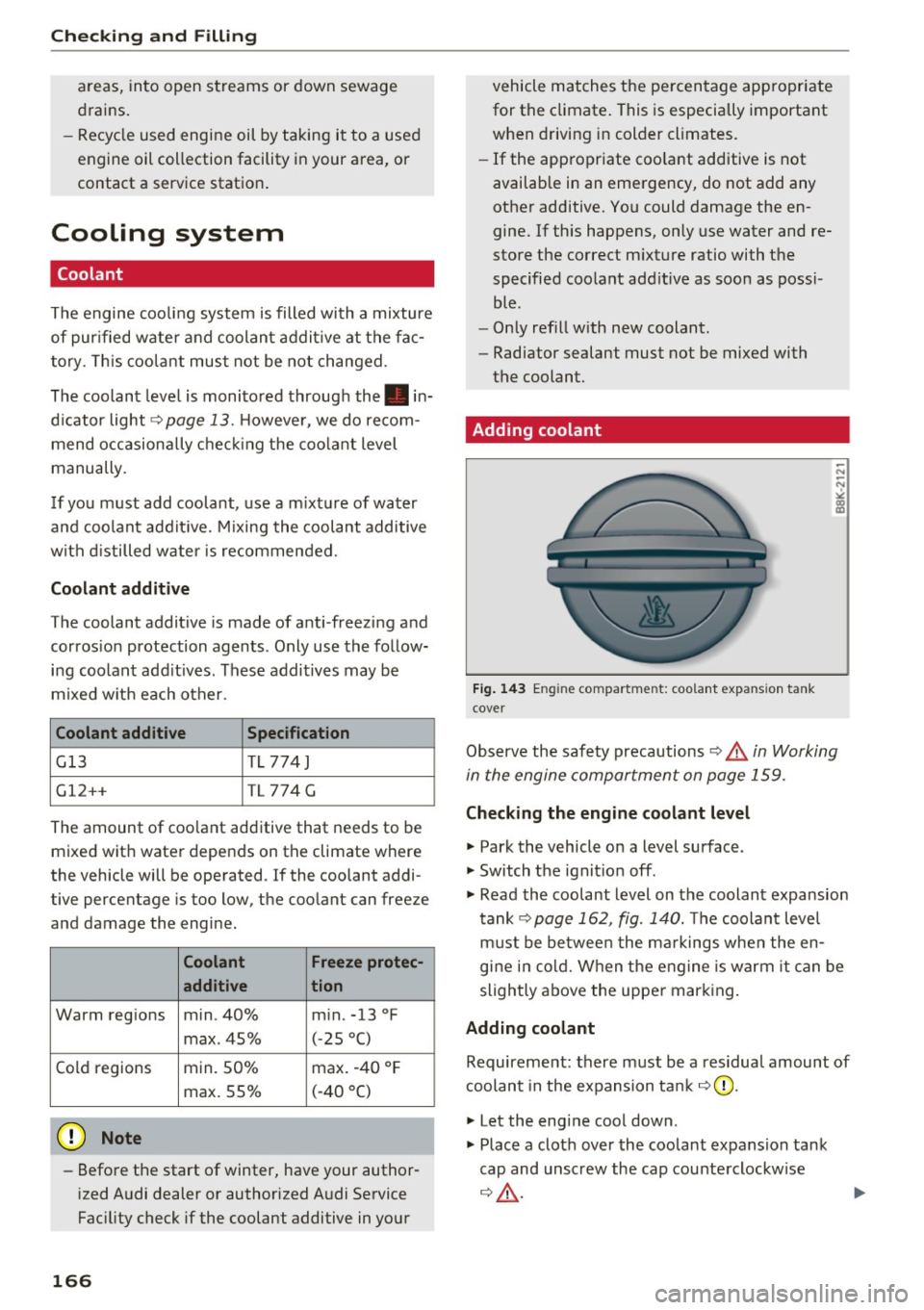
Check ing and F illing
areas, into open streams or down sewage
drains .
- Recycle used engine oil by taking it to a used
engine oil collection facility in your area, or
contact a service station .
Cooling system
Coolant
The engine coo ling system is filled wi th a mixture
of pur ified w ate r a nd coolan t addit ive at the fa c
tory . T h is coo lant must not be not changed.
The coolant leve l is monito red throug h the . in
d icator light~
page 13 . Howeve r, we do re com
mend occasionally check ing the coo la nt level
manually.
I f you must add coolant, use a m ixt ur e of wa ter
and coolant addit ive. M ixing the coolant additive
with d istilled wate r is recommen ded .
Coolant additive
The coolant additive is made of a nti-freezi ng a nd
corros ion protection agents . Only use the fo llow
i n g coolant add it ives. These additives may be
mixed w it h each other.
Coolant additive Specification
G13 TL774J
G12++ T
L 774 G
The amount of coo lant additive that needs to be
mixed wit h wate r depends on the climate where
the vehicle will be operated . If the coolant addi
tive percentage is too low, the coolant can freeze
and damage the engine.
Coolant Freeze protec-
additive tion
Warm reg ions min . 40% m in . -13 °F
max . 45% (
- 25
°()
Co ld regions min. 50% max
. -40 °F
max. 55% (-40 °()
0 Note
- Befo re the start of winter, have your author
i zed Audi dealer or authorized A udi Service
Fac ility check if the coolant additive in you r
166
vehicle matches t he percentage app ropriate
for the climate . This is especially important
when driving in colder climates.
- If the app ropriate coo lant additive is not
available in an eme rgency, do not add any
other additive. You could damage the en
gine. If this happens, only use water and re
store the correct m ixture ratio with t he
specified coo lant add itive as soo n as poss i
bl e.
- Only ref ill w ith new coolant.
- Radiator sealant must not be mixed with
the coolant.
· Adding coolant
Fi g. 14 3 En gin e compartment: coo lant expa nsio n ta nk
cove r
Observe the safety precautions ~.& in Working
in the engine compartment on page 159 .
Checking the engine coolant level
.. Park the vehicle on a level surface .
.. Switch the ignit io n off.
.. Read the coolant level on the coolant expansion
t ank ~
page 162, fig. 140. The coolant leve l
m ust be be twee n the m arkings when the en
gi ne i n co ld. W hen t he engine is warm it can be
slightly above the upper mar king.
Adding coolant Requirement: there must be a residua l amount of
coolan t in the expansion tank ~(}).
.,. Let the engi ne cool down .
.. Place a clot h over the coolant expans ion tank
cap and unscrew the cap counte rclockw ise
~ .& -
Page 169 of 236
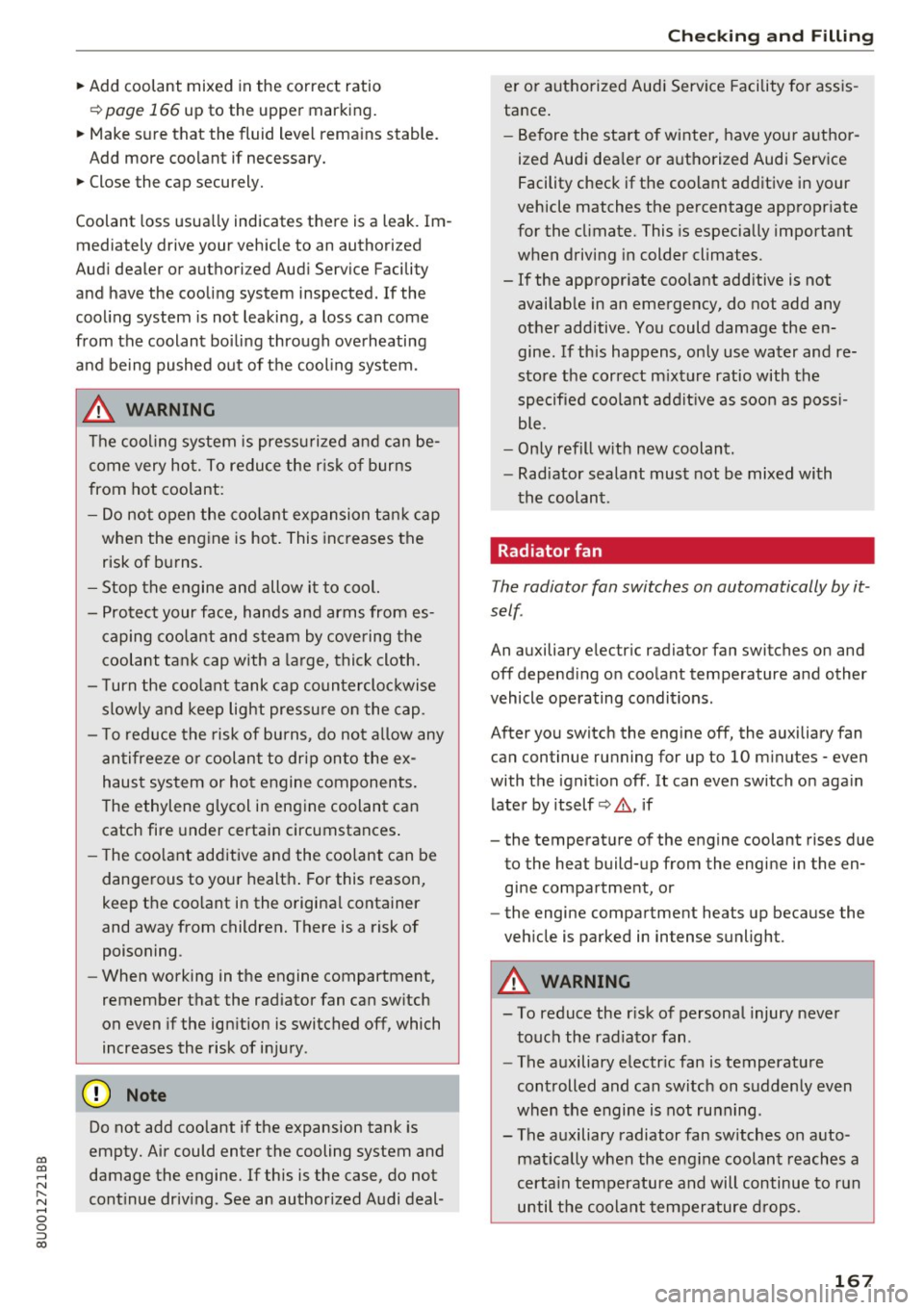
00
00
......
"' ,....
"' ...... 0 0 :::,
00
~ Add coolant mixed in the correct ratio
¢ page 166 up to the upper marking.
~ Make sure that the fluid level rema ins stable.
Add more coolant if necessary.
~ Close the cap securely.
Coolant loss usually indicates there is a leak. Im
mediately drive your vehicle to an authorized
Audi dealer or authori zed Audi Service Facility
and have the cooling system inspected. If the
cooling system is not leaking, a loss can come
from the coolant boiling through overheating
and be ing pushed out of the cooling system.
.&, WARNING
The cool ing system is pressu rized and can be
come very hot. To reduce the r is k of burns
from hot coolant :
- Do not open the coo lant expansion tank cap
when the engine is hot. This increases the risk of burns.
- Stop the engine and allow it to cool.
- Protect your face, hands and arms from es -
caping coolant and steam by covering the
coolant tank cap with a large, thick cloth .
- T urn the coo lant tank cap co unterclo ckwise
slowly and keep light pressu re on the cap .
- T o reduce the risk of burns , do not allow any
antifreeze o r coolant to drip onto the ex
haust system or hot engine components.
T he ethylene glycol in engine coolant can
catch fire under certain circumstances .
- T he coo lant add itive and the coolant can be
dangerous to your health . For this reason,
keep the coolant in the original container
and away from children. There is a risk of
poisoning.
- When working in the engine compartment,
remember that the radiator fan can switch
on even if the ignition is switched off, which
increases the risk of injury .
Do not add coolant if the expansion tank is
empty. Air could enter the cooling system and
damage the engine. If this is the case, do not
cont inue driv ing . See an authorized Audi deal -
Check ing and Filling
er or authorized Aud i Service Facility for assis
tance .
- Before the start of winter, have your author
ized Aud i dea ler or a uthorized Audi Serv ice
Facility check if the coolant additive in your
vehicle matches the percentage appropriate
for the climate. This is especially important
when driving in colder climates.
- If the appropr iate coo lant add itive is not
availab le in an emergency, do not add any
other additive . You could damage the en
gine. If this happens, only use water and re
store the correct m ixtu re ratio with the
specified coolant add it ive as soo n as poss i
ble .
- Only refill w ith new coolant.
- Radiator sealant must not be mixed with
the coolant .
Radiator fan
T he radiator fan switches on automatically by it
self.
An auxiliary e lectr ic radiator fan switches on and
off depend ing on coolant temperature and other
vehicle operating conditions.
After you switch the engine off, the auxiliary fan c a n continue running for up to 10 m inutes - even
with the ignition off . It can even switch on aga in
later by itself ¢.& , if
- the temperature of the engine coolant rises due
to the heat build-up from the engine in the en
gine compartment, or
- the engine compartment heats up bec ause the
veh icle is parked in in tense sunlight.
.&, WARNING
--
- To reduce the r isk of personal injury never
touch the radiator fan .
- The auxiliary e lectr ic fan is temperature
controlled and can switch on s uddenly even
when the engine is not runn ing .
- The auxiliary radiator fan sw itches on auto
mat ica lly when the eng ine coolant reaches a
certa in temperature and will continue to run
until the coolant temperature d rops .
167
Page 170 of 236

Checking and Filling
Brake fluid
N
N
~ N ,l: a, CXl
Fig. 14 4 Engine compartment: cap on brake fluid reservoir
Observe the safety precautions c:::> .&. in Working
in the engine compartment on page 159.
Checking th e br ake fluid l evel
.- Read the brake fluid level on the brake fluid
reservoir
c:::> page 162, fig . 140 . The brake fluid
level must be between the MIN and MAX mark
ings
c:::> ,&. .
The brake fluid level is monitored automatically .
Chang in g the b ra ke flu id
Have the brake fluid changed regularly by an au
thorized Audi dealer or authorized Audi Service
Facility .
A WARNING
-If the brake fluid level is below the MIN
marking, it can impair the braking effect
and dr iving safety, which increase the risk of
an accident. Do not cont inue driving . See an
authorized Aud i dealer or autho rized Audi
Service Facility for assistance.
- If the brake fluid is o ld, bubbles may form
in the b rake system du ring heavy b raking.
This would impair brak ing performance and
driving safety, which increases the risk of an
accident.
- T o ensure the brake system functions cor
rectly, only use brake fluids t hat comply
with VW standard 501 14 or
FMVSS-116 DOT 4.
(D Note
-If the brake fluid level is above the MAX
mark ing, brake fluid may leak out over the
168
edge of the reservoir and result in damage
to the vehicle.
- Do not get any brake fluid on the vehicle
paint, because it will corrode the paint.
Battery
General warnings about batteries
Because of the comp lex power supp ly, all wo rk
on batter ies such as d isconnecting, replacing,
etc. should
only be performed by an authorized
Audi dealer or authorized A udi Service Fac ility
c:::> &. .
The term "veh icle battery" refers to the 12 Volt
ba tte ry in your vehicle.
D etail ed warning s for th e vehicle batte ry:
®
Wear eye protection.
A
Battery acid is highly corrosive. Wear pro-
tect ive gloves and eye protection.
@
Fire, sparks, open flame and smoking are
forbidden .
&
A highly explosive m ixture of gases can
form when charging batter ies.
@
Keep children away from battery acid and
batteries.
A WARNING
All work on the battery or electrical system in
your vehicle can result in injuries, chem ica l
bu rns, acciden ts or burns. Because of this, all
wo rk mus t be performed
only by an autho r
i zed A udi dealer or authorized Aud i Service
Facility.
A WARNING
Ca lifornia Proposition 65 Warning:
- Batte ry posts, te rm inals and related acces
sories contain lead and lead compounds,
chemicals known to the State of California
to cause cancer and reproductive problems.
Wash hands after handling.
-
Page 171 of 236
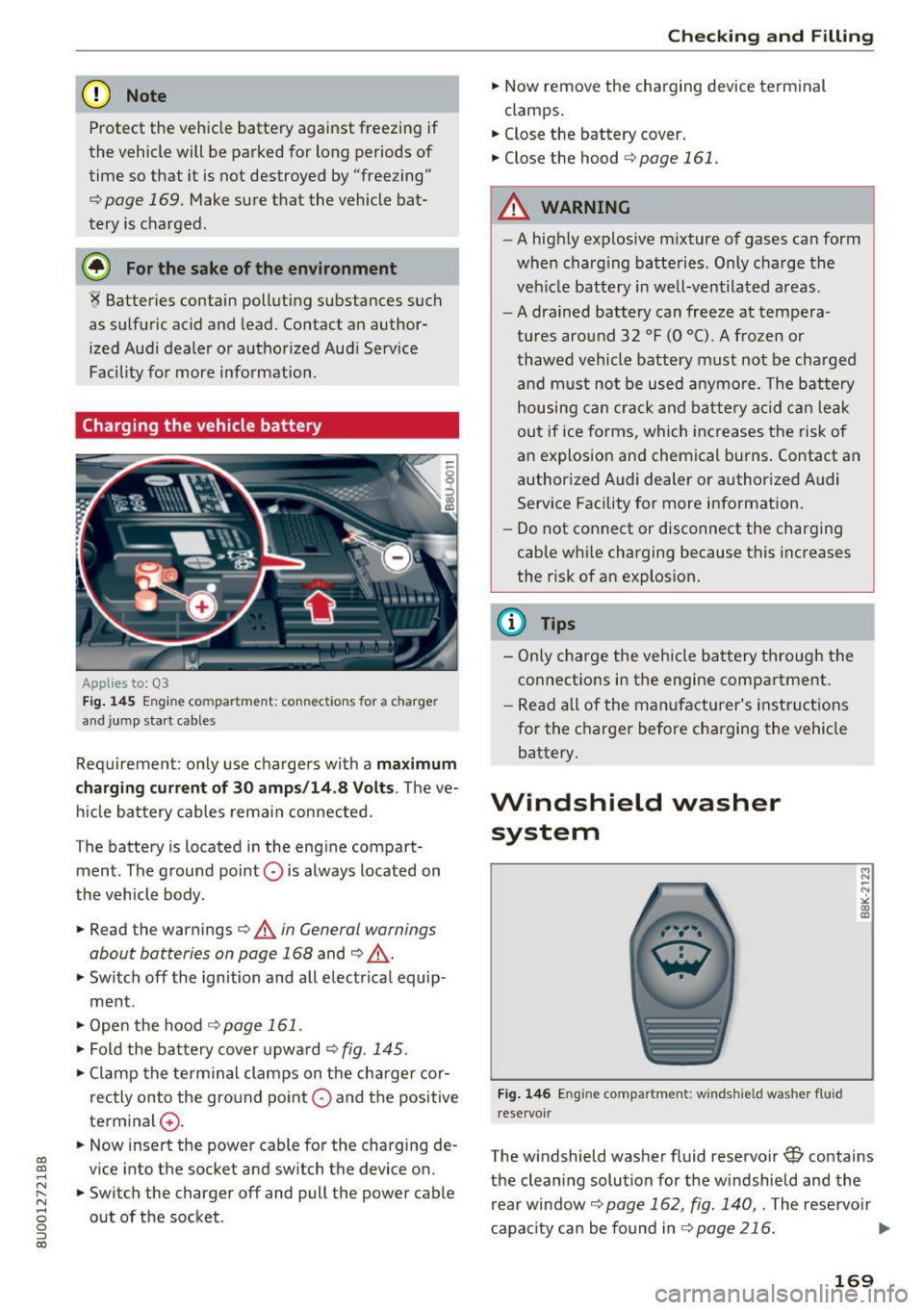
a:,
a:,
...... N r--. N .... 0 0 ::, a:,
(D Note
Protect the vehicle battery against freezing if
the vehicle will be parked for long periods of time so that it is not destroyed by "freezing"
c;,page 169. Make sure that the vehicle bat
tery is charged.
@) For the sake of the environment
¥ Batteries contain polluting substances such
as sulfuric acid and lead. Contact an author
ized Audi dealer or authorized Audi Service
Facility for more information .
Charging the vehicle battery
Applies to: Q3
Fig. 145 Engine compartment: connections for a charg er
and jump start cables
Requirement : only use chargers with a maximum
charging current of 30 amps/14.8 Volts .
The ve
hicle battery cables remain connected.
The battery is located in the engine compart
ment. The ground point
0 is always located on
the vehicle body .
.,. Read the warnings
c;, .&. in General warnings
about batteries on page 168
and c;, .&, .
.,. Switch off the ignition and all electrical equip-
ment .
.,. Open the hood
c;, page 161 .
.,. Fold the battery cover upward c;, fig. 145 .
.,. Clamp the terminal clamps on the charger cor
rectly onto the ground point
0 and the positive
terminal
0 .
.,. Now insert the power cable for the charging de
vice into the socket and switch the device on.
.,. Switch the charger off and pull the power cable
out of the socket .
Checking and Filling
.,. Now remove the charging device terminal
clamps.
.,. Close the battery cover.
.,. Close the hood
c;, page 161.
A WARNING
-- A highly explosive mixture of gases can form
when charging batteries. Only charge the
veh icle battery in well-ventilated areas.
- A drained battery can freeze at tempera
tures around 32 °F (0 °C) . A frozen or
thawed vehicle battery must not be charged
and must not be used anymore . The battery
housing can crack and battery acid can leak
out if ice forms, which increases the risk of
an explosion and chemical burns. Contact an
authorized Audi dealer or authorized Audi
Service Facility for more information.
- Do not connect or disconnect the charging
cable while charging because this increases
the risk of an explosion.
@ Tips
- Only charge the vehicle battery through the
connections in the engine compartment.
- Read all of the manufacturer's instructions
for the charger before charging the vehicle
battery.
Windshield washer system
Fig. 146 Engine compar tmen t: win ds hiel d washer flu id
re servoir
M N
-N ~ (D a,
The windshield washer fluid reservoir W contains
the cleaning solution for the windshield and the rear window
c;, page 162, fig . 140, . The reservoir
capacity can be found in
c;,page 216. .,.
169
Page 207 of 236
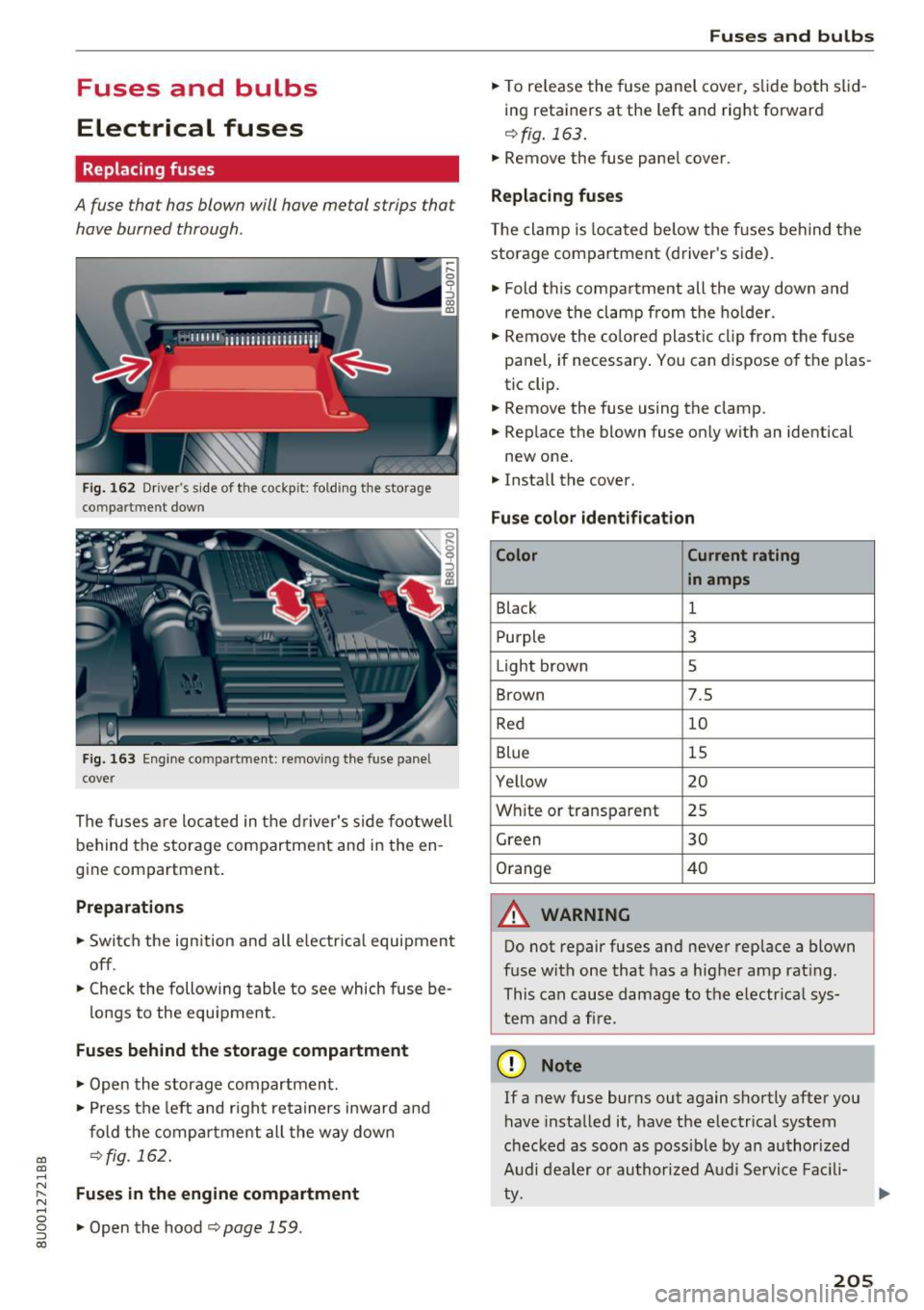
Fuses and bulbs
Electrical fuses
Replacing fuses
A fuse that has blown will have metal strips that
have burned through .
Fig. 162 Dr iver's side of th e cockpit: fold ing the storage
co mpartme nt down
Fig . 16 3 Engine compar tmen t: removing the fuse pane l
cover
The fuses are located in the driver 's side foo twell
be hind the storage compartment and in the en
g ine compartment .
Preparations
.. Switch the ign ition and all e lectr ica l equi pment
off.
.. Check the following table to see which fuse be -
l ongs to the equipment .
Fuses behind the storage compartment
.. Open the storage compartmen t.
.. Press t he left and r igh t re tainers inward and
fold the compartment all the way dow n
oo ¢fig. 162. a:, ...... N ~ Fuses in the engine compartment
'"' 0 g .. Open the hood ¢ page 159.
a:,
Fuses and bulbs
.. To re lease the fuse panel cove r, slide both s lid
ing retainers at the left and right forward
¢fig . 163 .
.. Remove the fuse panel cover.
Replacing fuses
T he clamp is loca ted below the f uses beh ind the
storage compartment (d river's side) .
.. Fold t his compa rtme nt all the way down a nd
remove t he cl amp from the ho lder .
.. Remove the co lored plas tic clip from the fuse
pane l, if necessary . You can d ispose o f the p las
tic clip .
.. Remove the fuse using the clamp .
.. Rep lace the blown fuse only with an identical
new one .
.. Insta ll the cover.
Fuse color identifi cation
Color Current rating
in amps
Black 1
P urple 3
Light brown 5
Brown 7.5
Red 10
Blue 15
Ye llow 20
W hite or transpa rent 25
Green 30
O range 40
A WARNING
Do not repair fuses and never rep lace a blown
f u se wit h one that has a hig her amp rat ing .
This can cause damage to the e lectr ica l sys
tem and a fir e.
(D Note
If a new fuse burns out again shortly after you
have insta lled it, have the electrical system
checked as soon as poss ible by an author ized
A udi dealer or au tho rized Aud i Service Fac ili
ty.
205
Page 211 of 236
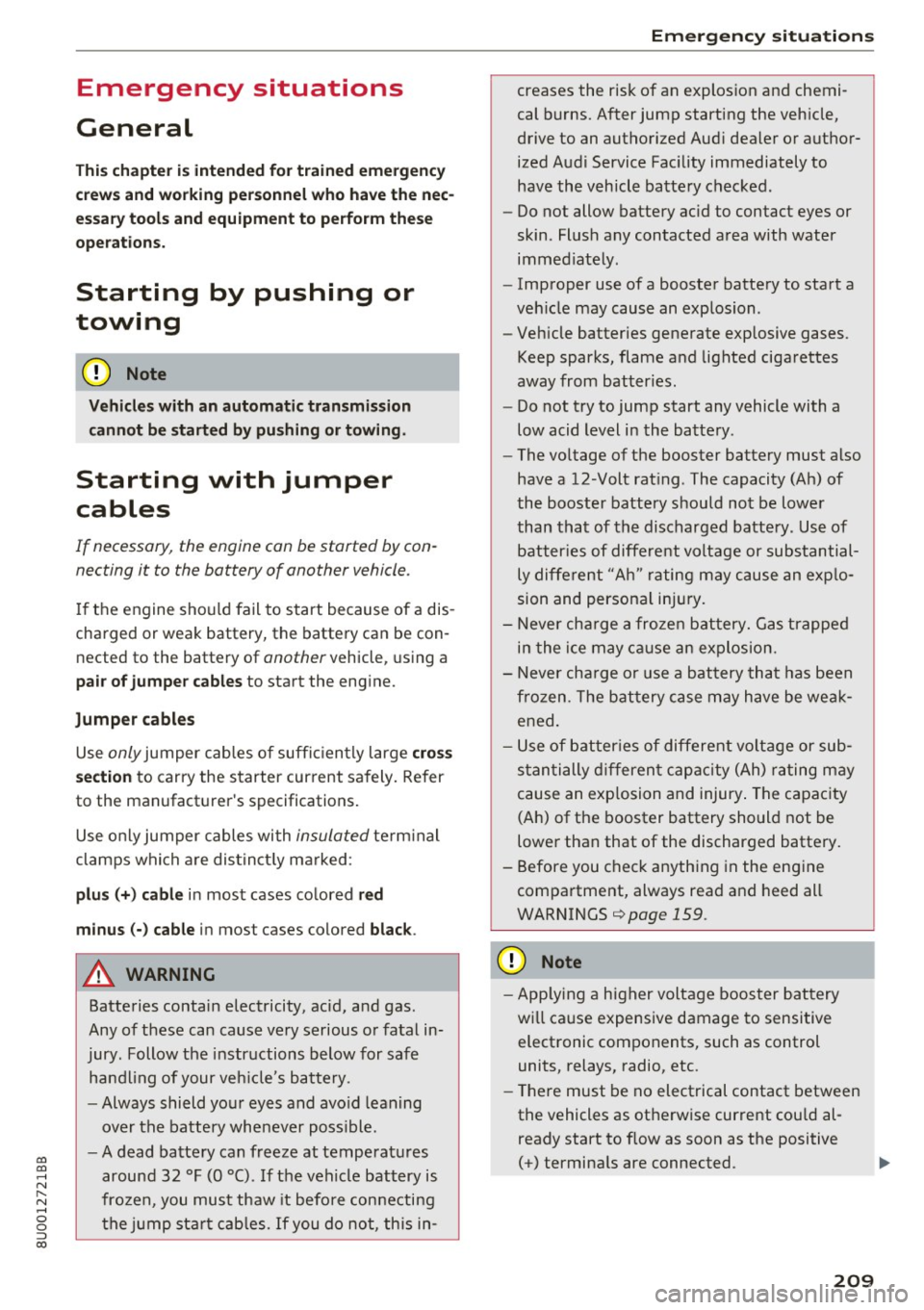
00
00
......
"' ,....
"' ...... 0 0 :::,
00
Emergency situations
General
This chapter is intended for trained emergency
crews and working personnel who have the nec
essary tools and equipment to perform these
operations.
Starting by pushing or
towing
CD Note
Vehicles with an automatic transmission
cannot be started by pushing or towing.
Starting with jumper
cables
If necessary, the engine can be started by con
necting it to the battery of another vehicle.
If the engine should fail to start because of a dis
charged or weak battery, the battery can be con
nected to the battery of
another vehicle, using a
pair of jumper cables to start the engine.
Jumper cables
Use only jumper cables of sufficiently large cross
section
to carry the starter current safely. Refer
to the manufacturer's specifications.
Use only jumper cables with
insulated terminal
clamps which are distinctly marked:
plus(+) cable in most cases colored red
minus(·) cable
in most cases colored black.
A WARNING
Batteries contain electricity, acid, and gas.
Any of these can cause very serious or fatal in
jury. Follow the instructions below for safe
handling of your vehicle's battery.
-Always shield your eyes and avoid leaning
over the battery whenever possible.
-A dead battery can freeze at temperatures
around 32 °F (0 °C). If the vehicle battery is
frozen, you must thaw it before connecting
the jump start cables. If you do not, this in-
Emergency situations
creases the risk of an explosion and chemi
cal burns. After jump starting the vehicle,
drive to an authorized Audi dealer or author
ized Audi Service Facility immediately to
have the vehicle battery checked.
- Do not allow battery acid to contact eyes or
skin . Flush any contacted area with water
immediately.
- Improper use of a booster battery to start a
vehicle may cause an explosion .
- Vehicle batteries generate explosive gases.
Keep sparks, flame and lighted cigarettes
away from batteries.
- Do not try to jump start any vehicle with a
low acid level in the battery .
- The voltage of the booster battery must also
have a 12-Volt rating. The capacity (Ah) of
the booster battery should not be lower
than that of the discharged battery. Use of
batteries of different voltage or substantial
ly different "Ah" rating may cause an explo
sion and personal injury.
- Never charge a frozen battery. Gas trapped
in the ice may cause an explosion.
- Never charge or use a battery that has been
frozen . The battery case may have be weak
ened.
- Use of batteries of different voltage or sub
stantially different capacity (Ah) rating may
cause an explosion and injury. The capacity (Ah) of the booster battery should not be
lower than that of the discharged battery.
- Before you check anything in the engine
compartment, always read and heed all
WARNINGS
qpage 159.
CD Note
-Applying a higher voltage booster battery
will cause expensive damage to sensitive electronic components, such as control
units, relays, radio, etc.
- There must be no electrical contact between
the vehicles as otherwise current could al
ready start to flow as soon as the positive
(+) terminals are connected.
209
Page 213 of 236
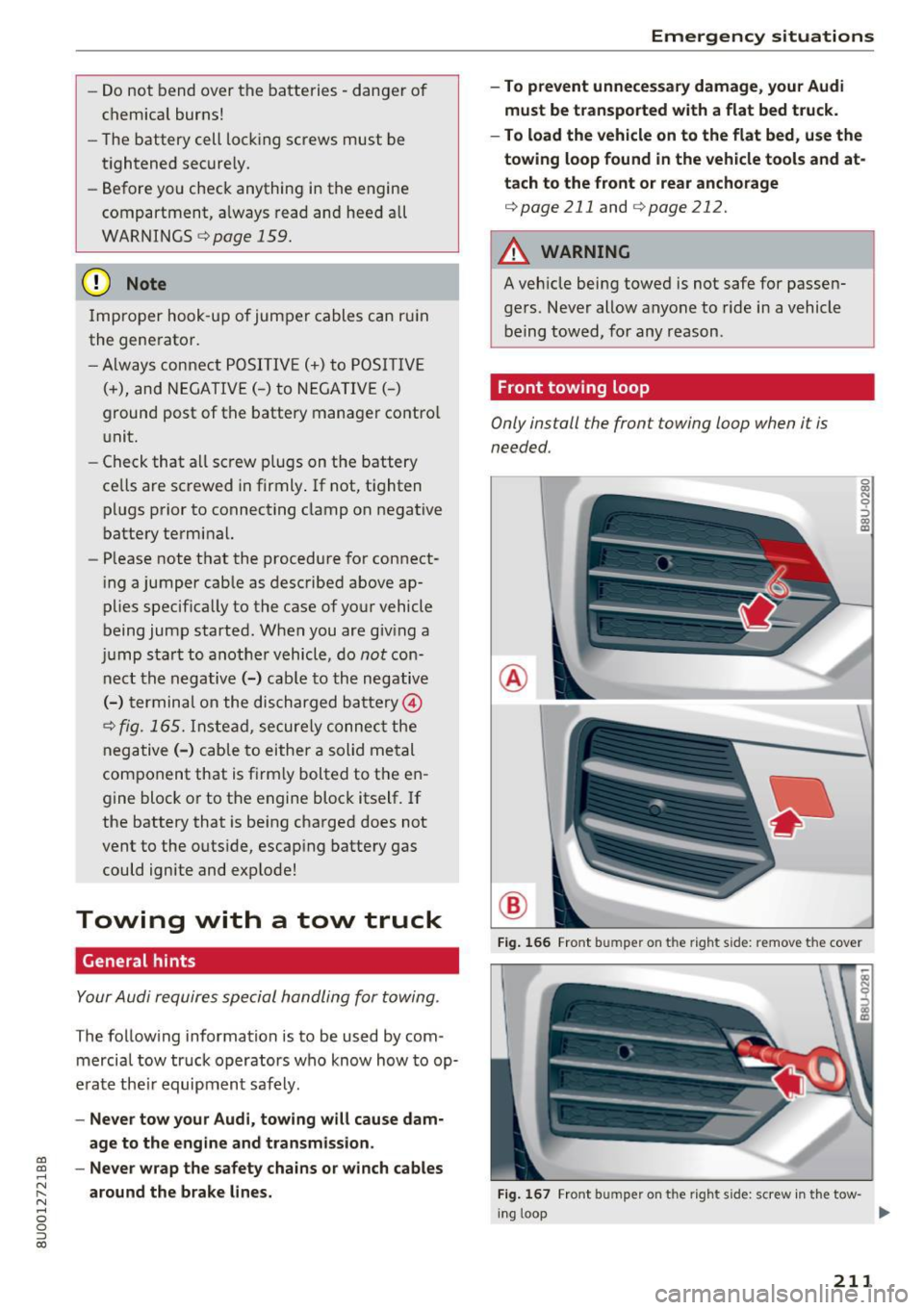
-Do not b end over the batteries -danger of
chemical burns!
- The battery cell locking screws must be
tightened securely.
- Before you check anyth ing in the engine
compartment, a lways read and heed all
WARNINGS
¢ page 159.
(D Note
Improper hook-up of jumper cables can ruin
the generator.
- Always connect POSITIVE(+) to POSITIVE
( + ), and NEGATIVE(-) to NEGATIVE(-)
ground post of the battery manager contro l
unit.
- Check that all screw p lugs on the battery
cells are screwed in firmly . If not, tighten
plugs prior to connecting clamp on negative
battery terminal.
- Please note that the procedure for connect
ing a jumper cable as described above ap
plies specif ically to the case of your vehicle
being jump started. When you are giv ing a
jump start to another vehicle, do
not con
nect the negative( -) cab le to the negative
(-) terminal on the discharged battery@
¢ fig. 165. Instead, securely connect the
negative (-) cable to either a solid metal
component that is firm ly bolted to the en
gine block or to the engine block itself. If
the battery that is being charged does not
vent to the outs ide, escaping battery gas
could ignite and explode!
Towing with a tow truck
General hints
Your Audi requires special handling for towing .
The follow ing information is to be used by com
mercial tow tr uck operators who know how to op
erate their equipment safely .
-Never tow your Audi, towing will cause dam-
age to the engine and transmission .
a:, ~ -Never wrap the safety chains or winch cables
~ around the brake lines. N
"" 0 0 ::, a:,
Emergency situations
-To prevent unnecessary damage , your Audi
must be transported with a flat bed truck.
- To load the vehicle on to the flat bed, use the
towing loop found in the vehicle tools and at·
tach to the front or rear anchorage
¢ page 211 and ¢ page 212.
A WARNING ~ -
A veh icle being towed is not safe for passen
gers . Never allow anyone to ride in a vehicle
being towed, for any reason .
Front towing loop
Only install the front towing loop when it i s
needed.
®
®
0 0:, N 9 ::> 0:, a)
Fig. 166 Front bumpe r o n the right s ide: re move t he co ver
Fig. 167 Front bum pe r o n th e righ t side : screw in the tow-
in g loop ...
211
Page 216 of 236
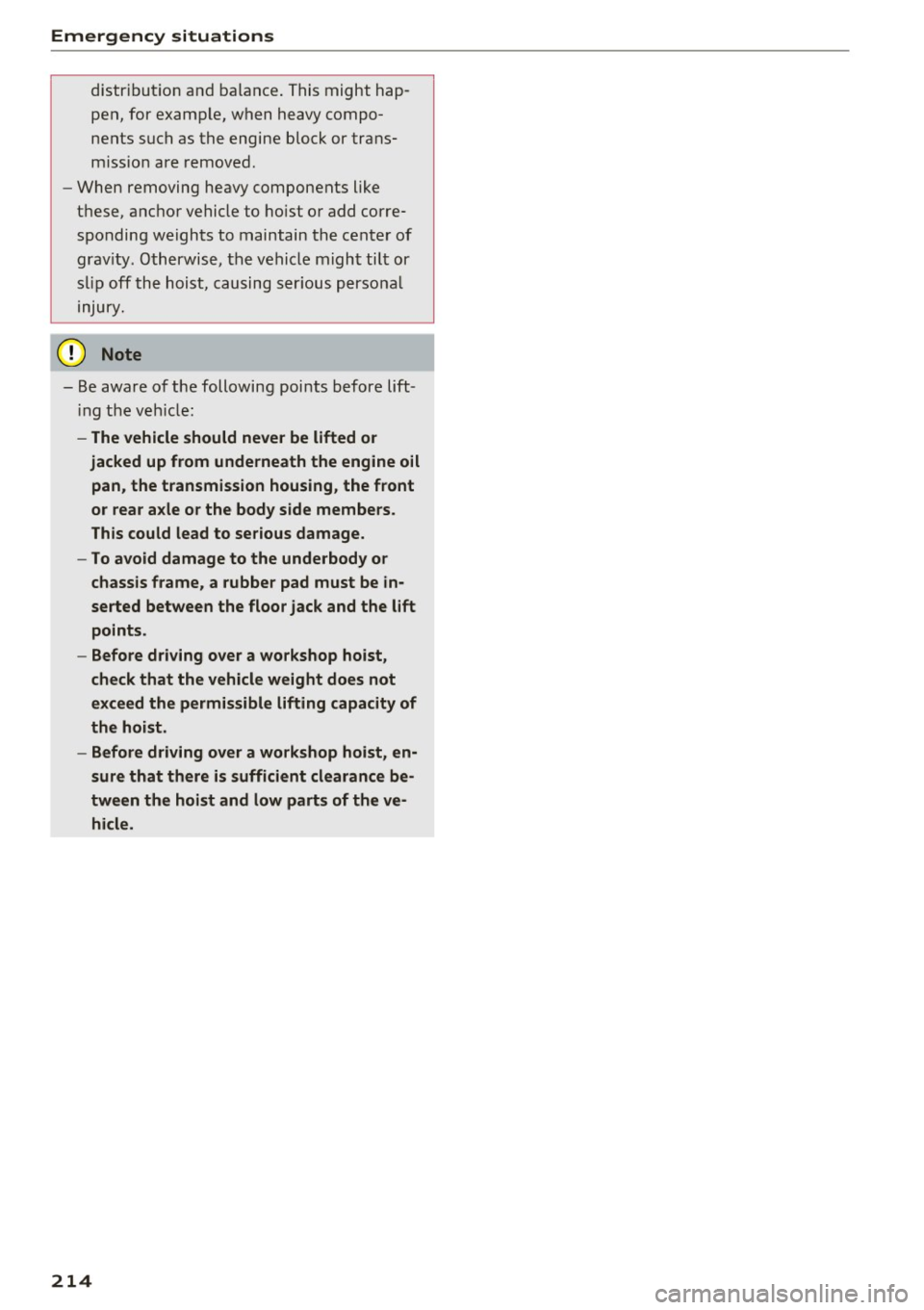
Emergency situations
distribut ion and ba lance . This might hap
pen, for example, when heavy compo
nents such as the engine block or trans
miss io n are removed.
- When removing heavy components like
th ese, a nch or vehicle to ho ist o r add corre
sponding weights to maintain the cen ter of
gr avity. Otherwise , th e vehicle migh t ti lt or
s lip off the hoist, causing s erious p erso nal
rnJury.
0 Note
- Be aware of t he following poi nts before lift
i ng t he veh icle:
-The vehicle should never be lifted or
jacked up from underneath the engine oil
pan , the transmission housing, the front
or rear axle or the body side members.
This could lead to serious damage.
- To avoid damage to the underbody or
chassis frame, a rubber pad must be in·
serted between the floor jack and the lift points.
- Before driving over a workshop hoist,
check that the vehicle weight does not
exceed the permissible lifting capacity of
the hoist .
- Before driving over a workshop hoist, en
sure that there is sufficient clearance be
tween the hoist and low parts of the ve ·
hide .
214
Page 217 of 236

a:,
a:,
.... N
" N .... 0 0 ::, a:,
Technical data
Vehicle specifications
XXXXX XX · X · XXXX XXX xx
CD-+ IAH RIG.- IOENT • NII. VOE£ • WIT • Nil. XXXXXX XX XX X XX XXX XXX
IYP/TYP! XXX XXX
xx xxxxxxx xx xx xx
XXX KW XXX
a.;. C1lll /TRANS. lllllE xxxx XXX XXX ®i 11)10Al<8 ./lil1R.k8.
©+ I.AO OIR. / IN NENAllSSl.
XXXX I XXXX XXX I XX PAI NT IIO. / ffT£ml
II. • AIJSlit / OPTIONS
EOA 70 5 4U B 6XM SSG SRW
2 EH JO Z 1LB 1AS l BA
3FC SM U 7Xl
F O A 9G3 OG7 OYH OJF
TL 6 3KA 8EH UlA X 9B OZ7
l XW
803 908 8Z4 020
7T6 CV7 7KO 4X3 2K 2
3 L4 4KC 3YO 413 50 2
lS A 7GB 01A 4GO
XX . X XX X XX X
xxxx
Fig. 173 Vehicl e identifica tion labe l
Vehicle Identification Number (VIN)
The VIN number is located in the following pla
ces :
0
0
a, '? :x: .,. al
-In the Infotainment system: se lect: the !CARI
func tion button > (Car}* systems control but
ton
> Servicing & checks > Vehicle ID number
(VIN).
- under the windshield on the driver's side*
- on the vehicle identification label
Vehicle identification label
The vehicle identification label¢ fig. 173 is locat
ed in the luggage compartment under the cargo
floor cover .
T he information of the vehicle identification label
can also be found in your Warranty
& Mainte
nance booklet.
The sticker contains the following vehicle data :
@ Vehicl e Identification Number (VIN)
@ Veh icle type, engine output, transmission
@ E ng ine and transm ission codes
Technical data
@ Paint and interior codes
® Optional equipment numbers
Safety compliance sticker
The safety compliance sticker is your assurance
that your new vehicle complies with all applicable
Federal Motor Vehicle Safety Standards which
were in effect at the time the vehicle was manu
factured. You can find this sticker on the door
jamb on the driver's side .
It shows the month and
year of production and the veh icle identificat ion
number of your vehicle (perforation) as well as
the Gross Vehicle Weight Rating (GVWR) and the
Gross Axle We igh t Rating (GAWR).
High voltage warning label
The high voltage warning label is located in the
engine compartment next to the engine hood re
lease. The spark ignition system complies with
the Canadian standard ICES-002.
Weights
Gross Vehicle Weight Rating
The Gross Vehicle We ight Rating (GVWR), and
the Gross Axle Weight Rating (GAWR) for front
and rear are listed on a sticker on the door jamb
o n the driver's side.
The Gross Vehicle We ight Rating includes the
we ight of the bas ic vehicle plus fu ll fuel tank, oil
and coolant, plu s maximum load, which includes
passenge r weight (1S0 lbs/68 kg per designated
seat ing position) and luggage weight¢.& .
Gross Axle Weight Rating
The Gross Axle Weight Rating is the maximum
load that can be applied at each axle of the vehi
cl e ¢ _& .
Vehicle capacity weight
The vehicle capacity weight (max. load) is listed
on the dr iver 's side 8-pillar .
Roof weight
The maximum p ermissible roof we ight is 165 lb
(7 5 kg). The roof weight is the total of the
weight of the roof rack, the attachments and the cargo you are carrying . ..,.
215
Page 221 of 236

00
00
......
"' ,....
"' ...... 0 0 :::,
00
today's a utomo biles, have steadily reduced the
scope of maintenance and repairs which can be
carried out by veh icle owners.
Also , sa fet y a nd
en vironmental
concerns place very strict limits
on the nature of repairs and adjustments to en
g ine and transm ission parts wh ich an owner can
pe rform .
Maintenance, adjustments and repairs usually re
qu ire special tools, test ing devices and other
equ ipment available to specially trained work
shop perso nnel i n order to assure proper per
formance, re liability a nd safety of the ve hicle and
its many systems.
Improper maintenance, adjustments and repairs
can impair the operation and re liab il ity of you r
vehi cle and eve n void your vehicle warra nty .
Therefo re, proof of se rvicing in accordance with
the m aintenance schedule may be a condition fo r
upho ld ing a possib le warranty claim made wi thin
the warranty period.
Above all , ope rational safety can be adversely af
fected, cre ating unnecessa ry risks fo r yo u and
your passengers.
I f in doubt about any se rvicing, have it done by
your author ized Audi dealer or any other prope rly
eq uipped and qua lified workshop. We strongly
urge you to g ive your author ized Audi dealer the
opportunity to perform a ll scheduled mainte
nance and necessary repairs. Your dealer has the
fac ilities, original parts and trained specialists to
keep your veh icle running properly .
Pe rforming limit ed ma intenance yourself
The fo llow ing pages describe a limited number of
procedures which can be performed on your vehi
cle with o rdinary tools, should the need arise and
tra ined personnel be unavailable. Before per
forming any of these procedures, always thor
ough ly read a ll of the app licab le text and careful
ly follow the instructions g iven . Always rigorously
observe the
WARNINGS prov ided .
Before you check an ything in the eng ine com
partment, alw ays read and heed all WARNINGS
c::> .&. and c::> .&. in Working in the engine compart
ment on page 159 .
Consumer inf ormation
A WARNING
- Ser ious personal in jury may occur as a result
of improperly performed maintenance, ad
justments or repairs .
- Always be extremely careful when work ing
on the vehicle. Always follow commonly ac
cepted safety practices and general com mo n sense. Never risk pe rsonal injury.
- Do not attempt any of the mai ntenance,
checks or repairs described on t he following
pages if you are not fu lly familiar wi th these
or other proce dures with respect to the ve
h icle, o r are uncerta in how to pro ceed.
- Do not do a ny work withou t the prope r tools
a nd eq uipment. H ave the necessary wo rk
done by your au thorized Audi dealer or an
other proper ly equipped and qualified work
shop.
- The engine compa rtment of any motor ve hi
cle is a potent ially hazardous area . Never
reach into the area around or touch the radi
ator fan.
It is temperature controlled and
can switch on suddenly - even when the en
g ine is off and the ignition key has been re
moved. The rad iator fan switches on au to
mat ica lly when the coo la nt reaches a certain
tem perature and will continue to r un until
the coolant tem pera ture drops.
- Always remove t he ignition key befo re any
one gets under the vehicle.
- Always support your veh icle with safety
s tands if i t is necessary to work u nder neat h
the vehicle . The jack* s upplied w ith the vehi
cle is not adequate fo r this purpose and
could collapse caus ing serious personal in
jury.
- If you m ust wor k unde rneath the vehicle
with the w heels on the g round, always make
sure the vehicle is on level ground, that the
wheels a re always sec urely blocked and that
the engine cannot be started.
- Always make sure the transmission se lector
lever (automatic transmiss ion) is in P (Park
position) and the park brake is applied.
219